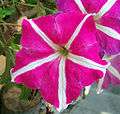Petunia
| Petunia | |
|---|---|
.jpg) | |
| Petunia exserta flower | |
| Scientific classification | |
| Kingdom: | Plantae |
| (unranked): | Angiosperms |
| (unranked): | Eudicots |
| (unranked): | Asterids |
| Order: | Solanales |
| Family: | Solanaceae |
| Subfamily: | Petunioideae |
| Genus: | Petunia Juss. |
| Species | |
|
See text. | |
Petunia is genus of 35 species of [1] flowering plants of South American origin, closely related to tobacco, cape gooseberries, tomatoes, deadly nightshades, potatoes and chili peppers in the same family, Solanaceae. The popular flower of the same name derived its epithet from the French, which took the word petun, meaning "tobacco," from a Tupi–Guarani language. An annual, most of the varieties seen in gardens are hybrids (P. × atkinsiana, also known as P. × hybrida).
Description
The plants are herbaceous, generally hairy, and the flowers are funnel-shaped, with petals joined together.[2] The fruit is a dry capsule with two compartments and many tiny seeds.[2]
Taxonomy
Petunia is a genus in the family Solanaceae, subfamily Petunioideae. Well known members of Solanaceae in other subfamilies include tobacco (Nicotianoideae), and the cape gooseberry, tomato, potato, deadly nightshades and chili pepper (Solanoideae).[3] Some botanists place the plants of the genus Calibrachoa in the genus Petunia,[4] but this is not accepted by others.[5][6][7] Petchoa is a hybrid genus derived from crossing Calibrachoa and Petunia.[8]
Ecology
Petunias are generally insect pollinated, with the exception of P. exserta, which is a rare, red-flowered, hummingbird-pollinated species. Most petunias are diploid with 14 chromosomes and are interfertile with other petunia species.[9][10]
The tubular flowers are favoured by some Lepidoptera species, including the Hummingbird hawk moth.[11] The flowers are eaten by the larvae of the corn earworm, Helicoverpa zea and the cabbage looper, Trichoplusia ni.[12]
Cultivation
Petunias can tolerate relatively harsh conditions and hot climates. They need at least five hours of sunlight every day. They grow well in low humidity, moist soil. Young plants can be grown from seeds. In drier regions, the plants should be watered daily.[13] Maximum growth occurs in late spring. Applying fertilizer monthly or weekly, depending on the variety, will help the plant grow quickly. Petunias can be cultivated in hanging baskets.
In horticulture many terms are used to denote different types of cultivated petunias. These include Grandiflora, Multiflora, Wave (Spreading), Supertunia, Cascadia, and Surfinia.
Uses
Many species other than P. × atkinsiana are also gaining popularity in the home garden.[14] A wide range of flower colours, sizes, and plant architectures are available in both P. × atkinsiana and other species, listed below:[4]
Species
Species include:[15]
- P. alpicola
- P. axillaris
- P. bajeensis
- P. bonjardinensis
- P. exserta
- P. guarapuavensis
- P. inflata
- P. integrifolia
- P. interior
- P. ledifolia
- P. littoralis
- P. mantiqueirensis
- P. occidentalis
- P. patagonica
- P. reitzii
- P. riograndensis
- P. saxicola
- P. scheideana
- P. villadiana
Gallery
- Flower pot planted with petunias
- A form of Petunia axillaris
- White Petunia axillaris
 A cultivated form
A cultivated form- Leaves of Petunia × atkinsiana
 A cultivated form
A cultivated form Some Petunia hybrids: magenta flower forms chosen from an F2 generation derived from P. nyctaginiflora pollinated from P. violacea
Some Petunia hybrids: magenta flower forms chosen from an F2 generation derived from P. nyctaginiflora pollinated from P. violacea Petunia flowers as gardening flowers
Petunia flowers as gardening flowers
References
- ↑ Maberly, D.J. 1990. The Plant Book. A portable dictionary of the higher plants. Cambridge Univ. Press, Cambridge, U.K.
- 1 2 Zhi-Yun Zhang; Anmin Lu & William G. D'Arcy, "Petunia Jussieu, Ann. Nat. Hist. 2: 214. 1803", Flora of China online, 17
- ↑ “Classification for Kingdom Plantae Down to Family Solanaceae”. Natural Resources Conservation Service. United States Department of Agriculture. 2009. Web. July 8, 2009.
- 1 2 Ellis, Barbara W. Taylor's Guide to Annuals. Boston. Houghton Mifflin Co. 1999. Print.
- ↑ The Plant List: Petunia
- ↑ Ando, T, Kokubun, H., Marchesi, E., Suárez, E. & Basualdo, I. 2005. Phylogenetic Analysis of Petunia sensu Jussieu (Solanaceae) using Chloroplast DNA RFLP. Ann. Bot. 96(2): 289 - 297.
- ↑ Kei-Ichiro Mishiba , Toshio Ando , Masahiro Mii , Hitoshi Watanabe , Hisashi Kokubun , Goro Hashimoto , and Eduardo Marchesi. 2000. Nuclear DNA Content as an Index Character Discriminating Taxa in the Genus Petunia sensu Jussieu (Solanaceae). Ann Bot 85: 665-673.
- ↑ The Value of Growing Petchoa SuperCal®. Ornamental News Oct 25 2012
- ↑ Ando, T., Nomura, M. Tsukahara, J., Watanabe, H., Kokubun, H., Tsukamoto, T., Hashimoto, G., Marchesi, E., Kitching, I.(2001) Reproductive isolation in a native population of Petunia sensu Jussieu (Solanaceae) Ann. Bot. (Lond.) 88:403–413.
- ↑ Griesbach, R.J.(2007) in Flower breeding and genetics: Issues, challenges and opportunities for the 21st century, Petunia, ed Anderson N.O. (Springer, Dordrecht, The Netherlands), pp 301–336.
- ↑ Butterfly Conservation
- ↑ "Colored and white sectors from star-patterned petunia flowers display differential resistance to corn ear worms and cabbage looper larvae".
- ↑ Brown, Deborah. “Growing Petunias” University of Minnesota Extension Office. University of Minnesota. 2009. Web. 25 June 2009. http://www.extension.umn.edu/distribution/horticulture/DG1120.html
- ↑ Allan M. Armitage, Armitage's Manual of Annuals, Biennials, and Half-Hardy Perennials (Portland: Timber Press, 2001).
- ↑ The Plant List, retrieved 13 September 2015
External links
| Wikispecies has information related to: Petunia |
| Wikimedia Commons has media related to Petunia. |
- The Petunia Platform - a platform for Petunia-related research